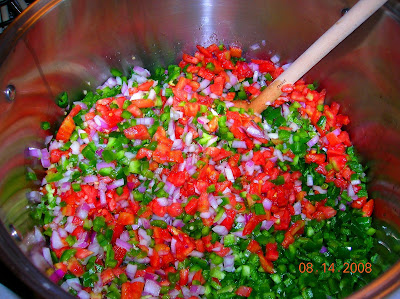 When I left for college, my cooking repertoire consisted of unintentionally scrambled French toast. Eight years later, after marriage to a man who taught me the proper way to treat an onion, I'm absolutely passionate about cooking, and I've got my own in-house tasting panel: Abigail (4), Juliet (2), and Isaac (7 weeks). I fund my love affair with French cheeses by teaching part-time at a nearby university and work off the cheese guilt by training for a half-marathon.
When I left for college, my cooking repertoire consisted of unintentionally scrambled French toast. Eight years later, after marriage to a man who taught me the proper way to treat an onion, I'm absolutely passionate about cooking, and I've got my own in-house tasting panel: Abigail (4), Juliet (2), and Isaac (7 weeks). I fund my love affair with French cheeses by teaching part-time at a nearby university and work off the cheese guilt by training for a half-marathon.You can read more about Rachael, her prolific garden, and her darling little family on her blog.
Thanks for being here, Rachael!
Three years ago, our family moved to the Midwest for my husband to pursue a doctoral degree. I was devastated to leave the mountains, but also excited to live in a hotbed of farmers’ markets, u-pick fruit farms, and to grow a garden of my own. My parents always had a ridiculously enormous garden, and most of the summer mornings of my childhood came with the stipulation that we had to do x amount of food processing before we were free to go off and play. While I’d been a helper all through my childhood and adolescence, it’s a bit intimidating when you come home from vacation to 100 lbs of ripe tomatoes, or return from a local orchard with a trunk full of peaches, and you are the one giving the orders!
Fortunately, it’s a fairly simple process, once you get the rhythm down and all the pieces in place. If you can sit in a friend’s kitchen and watch her do a batch of jam or applesauce, you’ll see what I mean, which is exactly the purpose of this post—to be a virtual window into my harvest kitchen (but without the stickiness and children underfoot!) It is best, however, to do your canning with another person around to help, since there tend to be long periods of repetitive work (like slicing peaches) with sudden bursts of frenzied activity (like ladling boiling jam into very hot jars).
There are three main areas of food preservation:
*canning
*freezing
*dehydrating.
I use a boiling-water canner for jams and fruits. Since most vegetables need to be processed in a pressure cooker, which I don’t have, I freeze most of my veggies, and I dehydrate tomatoes and some fruits. Freezing and dehydrating are fairly fool-proof, although there are some preparatory steps to both; canning is a bit more complex.
Before you get started, there’s some basic equipment you need to have on hand. For all three methods, I’d recommend that you have the following:
- Enormous bowls (I bought mine at a restaurant-supply store)
- Colanders
- Stockpot(s)
- Dry dishtowels
- Lots of ice
- A cushioned mat to stand on (trust me on this!)
A dehydrator is great, but you can also use your oven. Freezer bags or boxes are an obvious must-have if you’re using the freezer.
If you are canning, you will also need a boiling-water canner or pressure cooker, a canning rack (fits inside the canner and holds the jars in place), a jar lifter, a magnetic lid lifter, canning jars and rings (resusable), lids (not reusable, since they only seal once), funnels, and a long-handled spoon.
If you are working with cherries, for $20 you can buy a commercial cherry pitter that is worth every penny. If you’re making applesauce, tomato sauce, or clear jellies, a food strainer (I recommend a Victorio strainer) is a great investment as well. Keep an eye on garage sales for canners, strainers, dehydrators, chest freezers, etc.
Last but not least, the very best advice I can give you is to get a copy of the Ball Blue Book, which is invaluable (and cheap!) This is where you’ll find specific instructions and recipes for any canned, frozen, or dehydrated food you can imagine. This also includes processing times as well as just recipes. I cannot emphasize enough the vital importance of following recipes and instructions EXACTLY when you are preserving food; the last thing you want is for your family to become sick from something you’ve canned.
Rachael will be back tomorrow with the how-to's of harvest preservation and tips for incorporating your preserved food into your everyday cooking throughout the year.









4 comments:
Ohh I can't wait! I am just getting ready to can some peaches. I am glad to have the instruction.
That's awesome Rachael, I can't wait to hear more. ;)
I used my friend's pressure cooker to jar some pork loin and it is the best thing ever! It was SUPER easy to heat up later and season for tacos.
Thanks for the tips, Rachel. This is uncharted territory (for the most part) for me. Glad you're sharing the wisdom with us :)
Rachael, you are so inspiring! I can't wait for tomorrow!
--Anne
Post a Comment